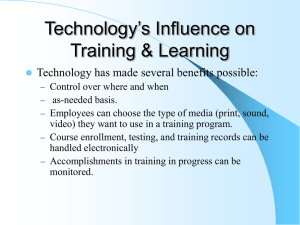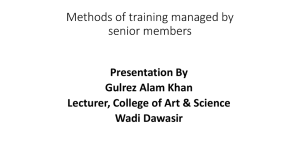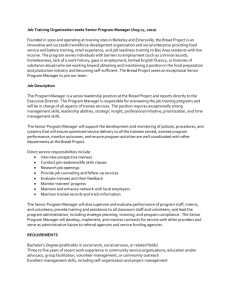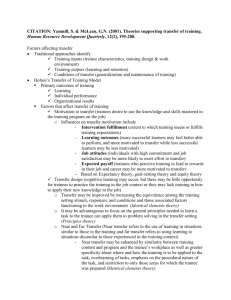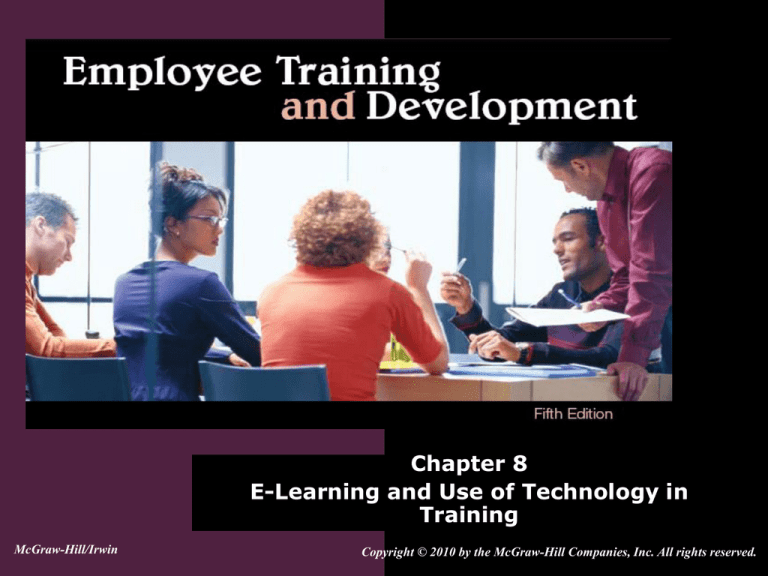
Chapter 8
E-Learning and Use of Technology in
Training
McGraw-Hill/Irwin
Copyright © 2010 by the McGraw-Hill Companies, Inc. All rights reserved.
Technology’s Influence on
Training and Learning
New technologies have made it possible
to:
reduce the costs associated with delivering
training.
increase the effectiveness of the learning
environment.
help training contribute to business goals.
8-2
Technology’s Influence on
Training and Learning (cont.)
New training delivery and instructional
methods include:
online learning (e-learning)
distance learning
simulations
virtual reality
expert systems
electronic support systems
learning management systems
8-3
Technology’s Influence on
Training and Learning (cont.)
Benefits of Technology
Employees can gain control over when and
where they receive training.
Employees can access knowledge and expert
systems on an as-needed basis.
The learning environment can look, feel, and
sound just like the work environment.
Employees can choose the type of media they
want to use in a training program.
8-4
Technology’s Influence on
Training and Learning (cont.)
Benefits of Technology
Paperwork and time needed for administrative
activities is reduced.
Employees’ accomplishments during training
can be monitored.
Traditional training methods can be delivered
to trainees rather than requiring them to
come to a central training location.
8-5
Technology’s Influence on
Training and Learning (cont.)
Digital collaboration
use of technology to enhance and extend
employees’ abilities to work together
regardless of their geographic proximity.
can be synchronous or asynchronous.
8-6
Technology’s Influence on
Training and Learning (cont.)
Prior to the introduction of new
technology:
Trainees played a passive role in learning.
Interaction among learners occurred primarily
outside the training room and tended to be
limited.
Due to technology, learning has become a
more dynamic process.
Instructor is more of a coach and resource
person.
8-7
Figure 8.1 - Types of Learning
Environments
8-8
Figure 8.1 - Types of Learning
Environments
8-9
Figure 8.1 - Types of Learning
Environments
8-10
Technology and Multimedia
Multimedia training - combines
audiovisual training methods with
computer-based training.
8-11
Table 8.2 - Advantages and
Disadvantages of Multimedia Training
8-12
Computer-Based Training
It is an interactive training experience in
which:
the computer provides the learning stimulus.
the trainee must respond.
the computer analyzes the responses and
provides feedback to the trainee.
It includes interactive video, CD-ROM,
and online learning.
CD-ROMs and DVDs utilize a laser to read
text, graphics, audio, and video off an
aluminum disk.
8-13
Computer-Based Training (cont.)
Interactive video - instruction is provided
one-on-one to trainees via a monitor
connected to a keyboard.
Online learning, or e-learning - instruction
and delivery of training by computer online
through the Internet or the Web.
Internet-based or Web-based, training training delivered on public or private computer
networks and displayed by a Web browser.
Intranet-based training - training that uses the
company’s own computer network; accessible only
to the company’s employees.
8-14
Figure 8.3 - Potential Features of
E-Learning
8-15
Table 8.3 - Advantages of ELearning
8-16
Table 8.4 - Research Results Regarding
the Effectiveness of Online Learning
8-17
Table 8.5 - Factors Limiting the
Use of E-Learning
8-18
Table 8.6 - Tips for Developing
Effective Online Learning
8-19
Table 8.6 - Tips for Developing
Effective Online Learning
8-20
Table 8.7 - Principles for
Designing E-Learning
8-21
Computer-Based Training (cont.)
Technology for collaboration and linking
Bandwidth - number of bytes and bits
(information) that can travel between
computers per second.
Online learning should try to build in
interactivity without requiring the use of
plug-ins - additional software that needs to
be loaded on the computer to listen to sound
or watch video.
8-22
Computer-Based Training (cont.)
Technology for collaboration and linking
Hyperlinks - links that allow a trainee to
access other Web sites that include printed
materials as well as communications links to
experts, trainers, and other learners.
Learning portals – Web sites or online
learning centers that provide, via e-commerce
transactions, access to training courses,
services, and online learning communities
from many sources.
8-23
Table 8.8 - Common Ways of
Collaboration in Online Learning
8-24
Blended Learning
It combines online learning, face-to-face
instruction, and other methods for
distributing learning content and
instruction.
In comparison to classroom delivery,
blended learning:
provides increased learner control.
allows for self-directedness.
requires learners to take more responsibility
for their learning.
8-25
Blended Learning (cont.)
In comparison to pure online learning,
blended learning provides:
more face-to-face social interaction.
ensures that at least some of the instruction
is presented in a dedicated learning
environment.
8-26
Blended Learning (cont.)
Advantages
Provides live feedback
from peers which is
preferable to feedback
received online.
Capitalizes on the positive
learning features inherent
in both face-to-face and
Web-based instruction.
Disadvantages
Demanding—requires
greater time commitment.
Fast-changing technology.
Insufficient management
support and commitment.
Difficult to understand and
implement.
8-27
Simulations
Avatars - computer depictions of
humans that are used as imaginary
coaches, coworkers, and customers in
simulations.
8-28
Table 8.9 – Types of Simulations
8-29
Simulations (cont.)
Advantages
Eliminates the need to travel to a
central training location.
Meaningful—gets trainees
involved in learning, and are
emotionally engaging.
Simulators provide a consistent
message of what needs to be
learned.
Can safely put employees in
situations that would be
dangerous in the real world.
Results in positive outcomes as
shorter training times and
increased ROI.
Disadvantages
High development costs.
Trainees may not be comfortable
in learning situations that lack
human contact.
8-30
Simulations (cont.)
Advantages
Virtual reality computer-based
technology that
provides trainees
with a threedimensional learning
experience allowing
them to experience
presence.
Disadvantages
Allows trainees to
Poor equipment
practice dangerous
that results in a
tasks without
reduced sense of
putting themselves
presence.
or others in danger. Poor presence may
More memory
result in the trainee
available for
experiencing
learning.
simulator sickness.
8-31
Simulations (cont.)
Advantages
Virtual worldscomputer-based,
simulated, three
dimensional
representation of
the real world
and a place to
host learning
programs or
experiences.
Imitates an actual workplace
without any harm.
Provides a place to meet with
trainers, managers, or other
employees who can serve as
teachers.
Useful for teaching
interpersonal skills.
Motivates learners by making
learning fun and interactive.
Enhances transfer of training.
Used for e-learning,
collaboration, and meetings.
Disadvantages
Lack of ease of use for
first-time users.
Potential risk of a
difficult keyboard and
mouse interface.
High investment of
time and money
required for
programming content.
Lack of evidence
supporting its
effectiveness for
learning.
8-32
Mobile Technology and Training
Methods: iPods, PDAs
Mobile technology consists of:
Wireless transmission systems (Wi-Fi and
Bluetooth)
Mobile devices (PDAs, GPS, RFID, etc.)
Software applications
Challenges:
Ensuring employees know when and how to take
advantage of the technology.
Ensuring employees can connect to a variety of
networks irrespective of their location or mobile
device.
8-33
Intelligent Tutoring Systems
(ITS)
They are instructional systems that use
artificial intelligence.
Three types of ITS environments:
Tutoring
Coaching
Empowering
8-34
Intelligent Tutoring Systems
(ITS) (cont.)
Different from other new training
technologies in several ways:
Has the ability to match instruction to
individual student needs.
Can communicate and respond to the
student.
Can model the trainee’s learning process.
Can decide, on the basis of a trainee’s
previous performance, what information to
provide.
8-35
Intelligent Tutoring Systems
(ITS) (cont.)
Different from other new training
technologies in several ways:
Can make decisions about the trainee’s level
of understanding.
Can complete a self-assessment resulting in a
modification of its teaching process.
8-36
Figure 8.4 - Components of
Intelligent Tutoring Systems
8-37
Distance Learning
It involves two types of technology:
Teleconferencing - synchronous exchange
of audio, video, and/or text between two or
more individuals or groups at two or more
locations.
Interactive distance learning (IDL) latest generation of distance learning, which
uses satellite technology to broadcast
programs to different locations and allows
trainees to respond to questions posed during
the training program using a keypad.
8-38
Distance Learning (cont.)
Advantages:
Company saves on travel costs.
Allows employees in geographically dispersed
sites to receive training from experts who
would not otherwise be available to visit each
location.
Disadvantages:
Lack of interaction between the trainer and
the audience.
Technology failures.
Unprepared trainers.
8-39
Table 8.10 - Conditions When Training
Support Technologies are Most Needed
8-40
Technologies for Training Support
Expert systems - technology that
organizes and applies the knowledge of
human experts to specific problems.
It has three elements:
A knowledge base.
A decision-making capability.
A user interface.
8-41
Technologies for Training Support
(cont.)
Groupware - enables multiple users to
track, share, and organize information
and to work on the same document
simultaneously.
Companies use groupware to improve
business processes, to improve meeting
effectiveness, as well as to identify and share
knowledge in the organization.
8-42
Technologies for Training
Administration
Interactive voice technology - uses a
conventional personal computer to create
an automated phone response system.
Imaging - scanning documents, storing
them electronically, and retrieving them.
Training software applications - used
to track information related to training
administration, employee skills,
employees’ training activities, online
learning, and transfer of training.
8-43
Learning Management Systems: Systems for
Training Delivery, Support, and Administration
Learning management system (LMS)
- a technology platform that can be used
to automate the administration,
development, and delivery of all of a
company’s training programs.
8-44
Table 8.12 - Features of Learning
Management Systems (LMSs)
8-45
Learning Management Systems: Systems for
Training Delivery, Support, and Administration
(cont.)
Advantages of LMSs:
Reduces travel and training related costs.
Reduces time for program completion.
Increase employees’ accessibility to training
across the business.
Provides administrative capabilities to track
program completion and course enrollments.
Allows companies to track all learning activity
in the business.
8-46
Learning Management Systems: Systems for
Training Delivery, Support, and Administration
(cont.)
The major reasons that companies adopt
an LMS are:
To centralize management of learning
activities.
Track regulatory compliance.
Measure training usage and employee
performance.
8-47
Learning Management Systems: Systems for
Training Delivery, Support, and Administration
(cont.)
Developing on LMS
Senior management needs to be convinced
that an LMS will benefit employees, improve
business functions, and contribute to overall
business strategies and goals.
The company must have an e-learning
culture.
The online learning environment needs to be
under the control of the learner.
8-48
Choosing New Technology
Training Methods
New technology training methods should
be considered when:
Sufficient budget and resources are provided.
Trainees are geographically dispersed.
Trainees are comfortable using technology.
It is a part of the company’s business strategy
and suits its culture.
Employees have a difficult time attending
scheduled training programs.
Current training methods allow limited time
for practice, feedback, and assessment.
8-49
Table 8.13 - Comparison of
Technology-based Training Methods
8-50

